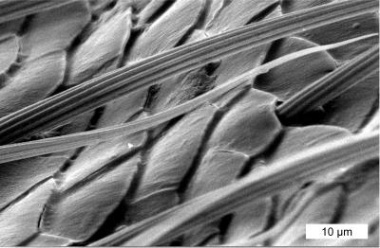
Photuris firefly scales
Researchers from Belgium, France and Canada have drawn inspiration from nature by mimicking the design of the bioluminescent firefly, which they say can help maximise the glow on LEDs by up to 55 per cent.
A recent study by the University of Namur in Belgium into the structure of the Photuris firefly found that the serrated scales of its abdomen enhance the glow emitted from it. It does this by minimising internal reflections, meaning more light is expelled. For fireflies, this extra light intensity proves useful when it comes to attracting a mate.
Scientists recreated the firefly’s serrated surface in the form of an LED overlayer, which increased light extraction considerably. It is hoped the overlayer can be applied to existing diodes to reduce the amount of light that gets lost to internal reflections.
Researchers at the University of Namur studied the fireflies using scanning electron microscopes and found structures such as nanoscale ribs and larger, misfit scales on the fireflies’ cuticles, a part of the insect’s exoskeleton. The researchers then used computer simulations to model how the structures affected light transmission and found that these misfit shapes let out the most light.
Nicolas André, a postdoctoral researcher at the University of Sherbrooke in Canada, created a jagged overlayer on a standard gallium nitrate LED. He deposited a layer of light-sensitive material on top of the LEDs and then exposed sections with a laser to create a triangular profile. The LEDs were made from a material that slowed light more than the fireflies’ cuticle, so André adjusted the dimensions accordingly to a height and width of five micrometers to maximise the light extraction.
The researchers say there is no need for a new LED to be created for this process. Instead, it is hoped that existing diodes can be easily coated and laser patterned.
Annick Bay, PhD student at the University of Namur, said: “The most important aspect of this work is that is shows how much we can learn by carefully observing nature. The Photuris fireflies are very effective light emitters but I am sure that there are other species that are even more effective. This work is not over.”
This research has been published in two papers in the Optical Society’s (OSA) open-access journal Optics Express.





